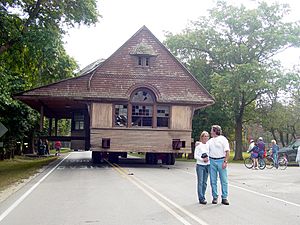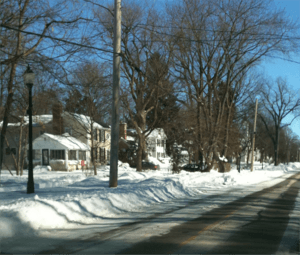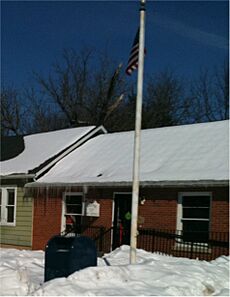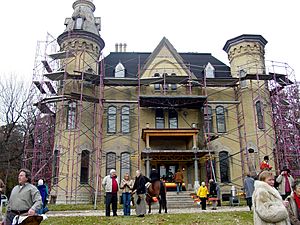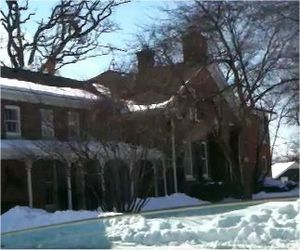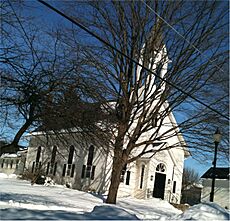Wayne, Illinois facts for kids
Quick facts for kids
Wayne, Illinois
|
|
|---|---|
| Village of Wayne | |
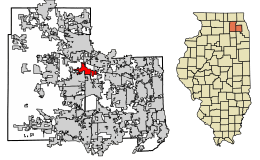
Location of Wayne in DuPage and Kane Counties, Illinois.
|
|
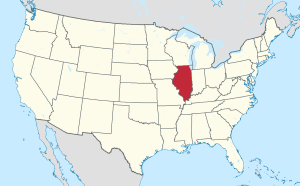
Location of Illinois in the United States
|
|
| Country | United States |
| State | Illinois |
| Counties | DuPage, Kane |
| Townships | St. Charles, Wayne |
| Founded | 1958 |
| Government | |
| Area | |
| • Total | 5.82 sq mi (15.08 km2) |
| • Land | 5.73 sq mi (14.84 km2) |
| • Water | 0.09 sq mi (0.24 km2) |
| Elevation | 742 ft (226 m) |
| Population
(2020)
|
|
| • Total | 2,286 |
| • Density | 398.95/sq mi (154.04/km2) |
| Time zone | UTC-6 (CST) |
| • Summer (DST) | UTC-5 (CDT) |
| ZIP Code(s) |
60184
|
| Area codes | 630 & 331 |
| FIPS code | 17-79397 |
| GNIS feature ID | 2400112 |
| Wikimedia Commons | Wayne, Illinois |
Wayne is a small village in Illinois, located in both DuPage and Kane counties. In 2020, about 2,286 people lived there.
Long ago, in the late 1800s and early 1900s, Wayne was famous for breeding horses and doing farm research. It was especially known for raising large French Percheron horses, which are strong draft horses like the Clydesdale. Wayne was founded in the 1800s. The village is much smaller than the cities around it. This is partly because of the natural Oak savanna and Tallgrass prairie lands nearby. These areas help keep the village green and natural.
Contents
History of Wayne
Wayne was first called Wayne Station. It was named after a person named Anthony Wayne. The village officially became a village in 1958. Before that, a group called the "Wayne Community Association" managed the area. They used donations to pay for services like police.
After World War II, Wayne started to grow. New neighborhoods were built in different parts of the village. Many people who live in Wayne travel to Chicago for work. They use train stations in nearby towns or drive to Chicago and other suburbs.
In 2007, an old train station was moved. It used to be at Dunham Castle but was originally on Army Trail Road. The station was moved back to its first spot. People in Wayne call this building "The Depot." It is now being fixed up. Other old railroad buildings were also moved to private properties in the village.
Dunham Castle and Oaklawn Farm
A very important building in Wayne is the Dunham Castle. It was built between 1878 and 1882. This stone building looks like a Norman castle and even has a tower! It was built by Mark Dunham, who was one of Wayne's first settlers. Mark Dunham was famous for breeding Percheron horses.
Mark Dunham's horse farm was called Oaklawn Farm. It started in Wayne in 1866. It was one of the first places in the U.S. to breed Percheron horses. Mark Dunham is even known as the "Father of the Percheron in North America." In 1893, during a big event called the World's Columbian Exposition, a special train brought guests from Chicago to see the horses at the 2,000 acres (8.1 km2) farm. Famous people like Cyrus McCormick and George Pullman visited.
When the Percheron horse business was at its best, Dunham built Dunham Castle. It was near the farm. The castle was designed to look like French country homes. It is made of brick and stone, with a colorful slate roof. Woods, gardens, and a grassy lawn surround it. Inside, it has fancy floors, statues, and copies of French art.
After Mark Dunham, his son Wirth inherited the castle in 1899. He passed away in 1931. In 1953, Dunham Castle was turned into four apartments. The inside structure was not changed. The castle has had several owners over the years. In 2013, it was sold again. The new owner started big renovations in 2016, which finished in 2021.
The castle is rarely open to the public. Sometimes, it opens for charity events. The original Dunham family home, which was not the castle, later became an inn and a place to sell horses. But as cars and tractors became popular, the demand for Percheron horses went down. Oaklawn Farm stopped being a big business. Today, the old farm offices are part of the Dunham Woods Riding Club. This is Wayne's only dining spot and social club.
Dunham Woods Riding Club
The Dunham Woods Riding Club started in 1934. It was created by people from Wayne and Geneva who rented the original Dunham family home. In 1950, a fire destroyed the old coach house. The club used the insurance money to buy the inn, a barn, a swimming pool, and tennis courts. Later, in 1957, they added a ballroom, a dining room, and a new kitchen.
More land was bought in 1961 and 1975. This included kennels for hounds and riding areas. The club leases some of this land to the Wayne-DuPage Hunt. In 1979, the area around the Dunham Woods Riding Club and Dunham Castle was added to the National Register of Historic Places. This means it is a special historical site.
Equestrian Traditions
The Village of Wayne loves its horse-riding history and wants to keep it alive. The village has many miles of paths just for horses. There are also many horse farms and places to ride or keep horses.
The Wayne-DuPage Hunt started in the 1920s. It is one of only two fox hunt groups still active near Chicago. This group does a "drag hunt," which means they follow a scent, not live foxes. The hunt has about 60 foxhounds and many members. They keep old traditions like the "stirrup cup" (a drink before or after the hunt) and the "hunt breakfast" (food after the hunt). The Wayne-DuPage Hunt Pony Club teaches young people how to ride, train, and care for horses.
Housing in Wayne
Homes in Wayne are very different. You can find small houses and very expensive estates worth millions of dollars. Many neighborhoods have houses that are similar in size and value. Most areas require at least one to 3-acre (12,000 m2) of land for a house. Much of the newer housing has been built since the 1970s. Some houses in the village are from the late 1800s.
In DuPage County, you need at least 2 acres (8,100 m2) to keep horses. In Kane County, outside of neighborhoods, you need at least 4 acres (16,000 m2). If a property has at least 2 acres (8,100 m2) in either county, it is called "zoned horses." This means you can have one horse per acre. Small buildings like horse stables are allowed, but they must follow village rules.
Community Events
Flag Day Celebration
Every June, residents and guests celebrate Flag Day. They have a parade and a picnic on the Sunday closest to June 14. The parade starts on Railroad Street at Army Trail Road. Everyone is welcome to join! The parade ends at the Little Home Church. People bring picnics and eat cakes donated by the community. A jazz band plays music.
During this event, a "Wayne Citizen of the Year" is announced. This person is honored for helping the village. The Wayne Community Association and the Village of Wayne organize this event.
Wayne Day and Other Gatherings
Wayne Day is celebrated around the first Saturday in October. It takes place in the fields east of the Dunham Club. People fly kites, have picnics, and enjoy an evening bonfire. This event started around 1997. It shows off community groups, local leaders, and historical displays. Community groups and the Village of Wayne work together to put on this event. In 2009, Wayne Day celebrated the village's 175th birthday.
Other events have also been held to raise money for the Wayne Police Department. For example, in 2017, a "Wayne Wine and Horse Fest" raised over $42,000! More "Wayne Wine and Horse Fest" events have happened since then, raising even more money. The Village of Wayne also started an annual Christmas Tree lighting event in 2021 by the Old Depot building.
Notable People
Some famous people have lived in Wayne:
- Marguerite Henry, a well-known author.
- George C. Marshall, a U.S. Army Chief of Staff and Nobel Peace Prize winner.
- Joy Morton, who founded Morton Salt.
Pratt’s Wayne Woods
Wayne has a very large forest preserve called Pratt's Wayne Woods. It is the biggest forest preserve in DuPage County. It covers 3,462 acres (14.01 km2) of land. When combined with nearby state land, it forms a huge 4,000 acres (16 km2) natural area. This is very special in a growing city area.
Pratt's Wayne Woods has savannas, marshes, meadows, and wetlands. These areas offer many chances to enjoy nature and go on outdoor adventures. There is a big project to restore the wetlands in the Brewster Creek area of the preserve.
The land for Pratt's Wayne Woods began to be set aside in 1965. This happened when the state of Illinois donated 160 acres (0.65 km2). Thanks to George Pratt, who worked for the preserve in the 1960s and 1970s, the Forest Preserve District bought more land.
The first private owner of this land was Mark Wentworth Fletcher. He bought 320 acres (1.3 km2) in 1846 and built a farmhouse. After Fletcher passed away, the land was sold a few times. Then, Mark Morton, one of the founders of the Morton Salt Company, bought it in 1926. He used part of the land for sand and gravel. The rest was used for farming until he died in 1951.
Later, Franz Palm bought the land. He turned it into a place for hunting and fishing. The Palm family wanted it to be their retirement spot. However, the state of Illinois had other plans. The state bought the original 320 acres (1.3 km2) to make a state park. When that idea was dropped, George Pratt convinced the District to buy the quarry area for a forest preserve. In 1974, Pratt sold his own 250 acres (1.0 km2) farm to the District, making the preserve even bigger.
For a long time, the wetlands in Pratt's Wayne Woods were drained by pipes. Now, the Forest Preserve District is removing these pipes. This helps restore the natural habitat. This area is home to many rare plants and animals.
In 1990, plans for a state park were brought back. The state and the Forest Preserve District bought over 300 acres (1.2 km2) near Pratt's Wayne Woods. This became James "Pate" Philip State Park, which is just north of Pratt's Wayne Woods. A large visitor center opened there in 2003. In 2004, more land was bought by the DuPage Forest Preserve District. This area is called Dunham Woods and is still being developed as a park.
Geography
Wayne covers about 5.82 square miles (15.07 km2) of land. Most of it is dry land (about 5.73 square miles (14.84 km2)), and a small part is water (about 0.09 square miles (0.23 km2)). The village has small streams, wetlands, and little ponds.
Population Information
| Historical population | |||
|---|---|---|---|
| Census | Pop. | %± | |
| 1960 | 373 | — | |
| 1970 | 572 | 53.4% | |
| 1980 | 940 | 64.3% | |
| 1990 | 1,541 | 63.9% | |
| 2000 | 2,137 | 38.7% | |
| 2010 | 2,431 | 13.8% | |
| 2020 | 2,286 | −6.0% | |
| U.S. Decennial Census | |||
In 2020, Wayne had 2,286 people living in 889 households. About 72% of households were married couples. The average age in the village was 50.3 years old. The median income for a household was $132,695. This means half of the households earned more than that, and half earned less. Only about 1% of the population lived below the poverty line.
Education
Students in Wayne attend schools in two different districts. The southern and western parts of the village are served by St. Charles District 303. The central, northern, and eastern parts are served by Elgin Area School District U-46.
District U-46 is very large, covering about 90 square miles (230 km2) across three counties. It is the second-largest school district in Illinois, with almost 40,000 students. Wayne has its own elementary school, Wayne Elementary. It is part of District U-46 and teaches about 600 children from kindergarten to 6th grade.
Sister City
Wayne has a "sister city" in France called Nogent-le-Rotrou. This means they have a special friendly relationship.
|
See also
 In Spanish: Wayne (Illinois) para niños
In Spanish: Wayne (Illinois) para niños


